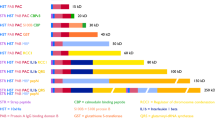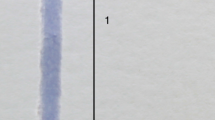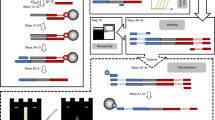Abstract
A rapid and simple method for the recovery of DNA fragments from an agarose gel is described. It involves a ten minute centrifugation of the DNA-containing gel layered on a GeneScreen (NEN) or a Durapore (Millipore, GVWP 04700) membrane. With the latter a recovery of about 70 percent has been obtained with DNA fragments in the range of 0.4 to 25 Kbp. The eluted DNA stays intact and has been used successfully for ligation, restriction digestion, fill-in reaction by Klenow polymerase, tailing and for priming reverse transcription. Therefore, it is particularly useful for construction of plasmids and for other recombinant DNA research.
This is a preview of subscription content, access via your institution
Access options
Subscribe to this journal
Receive 12 print issues and online access
$209.00 per year
only $17.42 per issue
Buy this article
- Purchase on Springer Link
- Instant access to full article PDF
Prices may be subject to local taxes which are calculated during checkout
Similar content being viewed by others
References
Yang, R.C.A., Lis, J. and Wu, R. 1979. Elution of DNA from Agarose gels after Electrophoresis. In: Methods in Enzymology, 68: 176–182. R. Wu (ed.), Academic Press, New York.
Dretzen, G., Bellard, M., Sassone-Corsi, P. and Chambon, P. 1981. A reliable method for the recovery of DNA fragments from agarose and acrylamide gels. Anal. Biochem. 112: 295–298.
Vogelstein, B. and Gillespie, D. 1979. Preparative and analytic purification of DNA from agarose. Proc. Nat. Acad. Sci. USA 76: 615–619.
Tautz, D. and Renz, M. 1983. An optimized freeze-squeeze method for the recovery of DNA fragments from agarose gels. Anal. Biochem. 132: 14–19.
Schmitt, J.J. and Cohen, B.N. 1983. Quantitative isolation of DNA restriction fragments from low-melting agarose by elutip-d affinity chromatography. Anal. Biochem. 133: 462–464.
Burns, D.M. and Becham, I.R. 1983. A method for the ligation of DNA following isolation from low melting temperature agarose. Anal. Biochem. 135: 48–51.
Zhu, J., Contreras, R., Gheysen, D., Ernst, J. and Fiers, W. 1985. A system for dominant transformation and plasmid amplification in Saccharomyces cerevisiae. Bio/Technology, 3: 451–456.
Ruther, U., Koenen, M., Otto, K. and Miller-Hill, B. 1981. pUR222, a vector for cloning and rapid chemical sequencing of DNA. Nucleic Acids Res. 9: 4087–4097.
Okayama, H. and Berg, P. 1982. High-efficiency cloning of full-length cDNA. Molecular and Cellular Biology 2: 161–170.
Roychoudhury, R., Jay, E. and Wu, R. 1976. Terminal labelling and addition of homopolymer tracts to duplex DNA fragments by terminal deoxynucleotidyl transferase. Nucleic Acids Res. 3: 863–877.
Weiss, B., Jacquemin-Sablon, A., Live, T.R., Fareed, G.C. and Richardson, C.C. 1968. Enzymatic breakage and joining of deoxyribonucleic acid. J. Biol. Chem. 243: 4543–4555.
Maniatis, T., Fritsch, E.F. and Sambrook, J. eds. 1982. Molecular Cloning, A Laboratory Manual. Cold Spring Harbor Laboratory, New York.
Author information
Authors and Affiliations
Rights and permissions
About this article
Cite this article
Zhu, J., Kempenaers, W., Van der Straeten, D. et al. A Method for Fast and Pure DNA Elution from Agarose Gels by Centrifugal Filtration. Nat Biotechnol 3, 1014–1016 (1985). https://doi.org/10.1038/nbt1185-1014
Received:
Accepted:
Issue Date:
DOI: https://doi.org/10.1038/nbt1185-1014
This article is cited by
-
A rapid and cost effective method in purifying small RNA
World Journal of Microbiology and Biotechnology (2012)
-
Restriction and gene maps of plastid DNA from Capsicum annuum
Current Genetics (1986)



